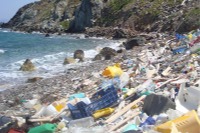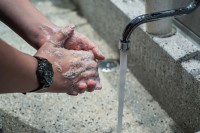
By simply switching from buying single-use plastic bottled water to using pure filtered tap water from your own home, you can save money and the environment.
Consumers continue to drink bottled water in part because they think it is safer or better than tap water. Consumers spend much more per litre for water in a plastic bottle than they would for water flowing from their own taps. Rather than buying into this myth of purity in a bottle, consumers should drink from the tap. Bottled water generally is no cleaner, or safer, or healthier than tap water.
In some cases, beverage and bottled water companies use misleading labels, including marketing bottled tap water as spring water. It is estimated that as much as 40 percent of bottled water is bottled tap water. The production of single use plastic bottles uses lots of energy and emits toxic chemicals and emissions. Transporting the bottled water across hundreds or thousands of miles further emits carbon dioxide into the air, complicating efforts to combat global climate change. But possibly worse of all, plastic bottles are piling up in landfills or ending up in our environment, particularly the oceans.
Bottled Water Facts:
- It is estimated that 2.5 million plastic bottles are thrown away every HOUR!
- Last year alone, Americans tossed over a billion dollars worth of empty plastic water bottles into landfills.
- It takes about 4 liters of water to make a plastic water bottle and each year 17 million barrels of oil are used in producing single-use bottles (enough to power a million cars for a year)
- Bottled water companies are not required to publish their water quality testing results and many companies don’t.
- There have been over 100 bottled water recalls since 1990 for contaminants ranging from algae, yeast, mold and sand to filth, coliform bacteria, bromate (a suspected human carcinogen), arsenic and benzene (a known human carcinogen). In most cases, the public was notified months after the contaminated water was found; in several cases, the public was not notified at all.
- Each year it is estimated that 2,500,000 tons of a carbon dioxide are emitted in the manufacturing of the plastic bottles.
- Bottle manufacturers waste about 272 billion liters of water a year, worldwide, just to make the empty bottles.
- The mining of water from aquifers and springs can lower the local water table, reducing stream flow, depleting aquifers, drying up water available from wells and draining wetlands.
- It will take over 700 years for plastic water bottles just to start decomposing and over 1,000 years to fully decompose.
- Plastic bottles are contributing to a swirling mash of plastic trash floating in the Great Pacific Ocean Garbage Patch estimated to be the size of Texas.
- Approximately 85% of plastic water bottles DO NOT make it to the recycling stage, they end up in land-fills or worse in the environment and oceans.
- Each second approximately 1,500 bottles end up in landfills or the ocean.
- The UN environmental program estimates that there is 46,000 pieces of plastic per square mile floating in the ocean.
- 80% of ocean pollution comes from land based activity.
- The Algalita Marine Research foundation found in a study of 660 fish that on average each fish contained more than 2 pieces of plastic. One fish had 26 particles.
- Plastic is listed as the number one threat to our marine environment by many researchers and environmental organizations.
- Millions of birds, mammals and fish die each year from plastic pollution either through ingestion or entanglement.
- In turtles, ingested plastic has been shown to clog intestines and make the animals float so they can’t dive for food.

